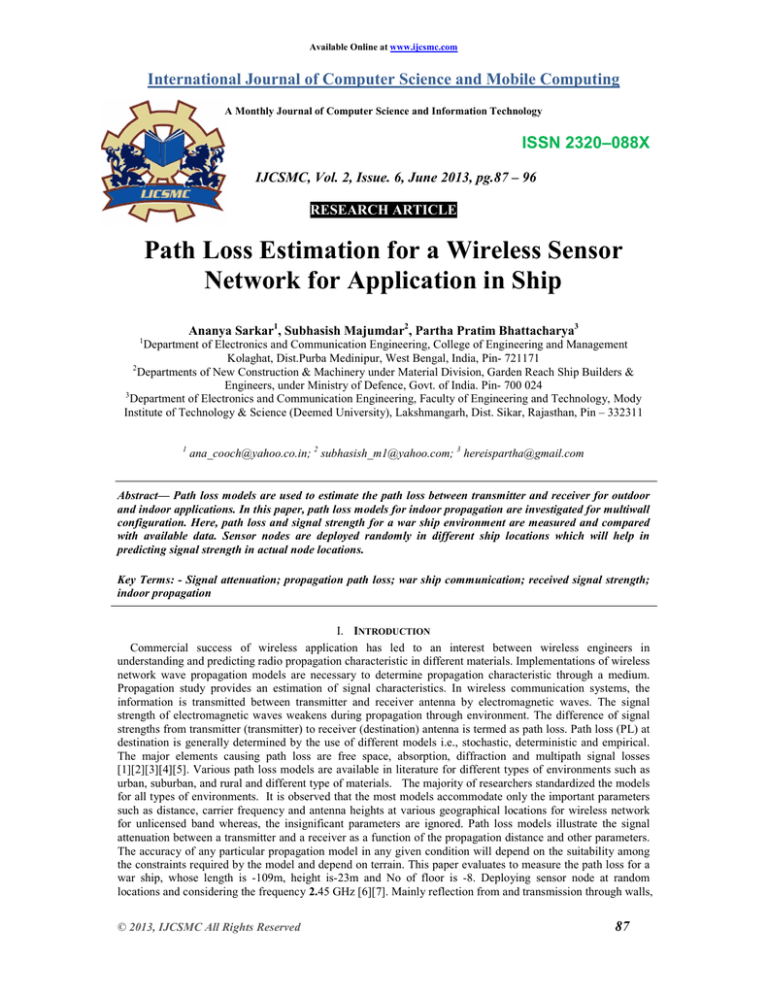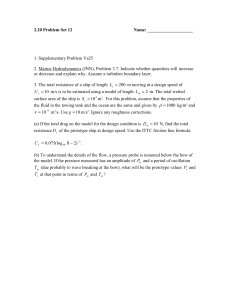
Available Online at www.ijcsmc.com
International Journal of Computer Science and Mobile Computing
A Monthly Journal of Computer Science and Information Technology
ISSN 2320–088X
IJCSMC, Vol. 2, Issue. 6, June 2013, pg.87 – 96
RESEARCH ARTICLE
Path Loss Estimation for a Wireless Sensor
Network for Application in Ship
Ananya Sarkar1, Subhasish Majumdar2, Partha Pratim Bhattacharya3
1
Department of Electronics and Communication Engineering, College of Engineering and Management
Kolaghat, Dist.Purba Medinipur, West Bengal, India, Pin- 721171
2
Departments of New Construction & Machinery under Material Division, Garden Reach Ship Builders &
Engineers, under Ministry of Defence, Govt. of India. Pin- 700 024
3
Department of Electronics and Communication Engineering, Faculty of Engineering and Technology, Mody
Institute of Technology & Science (Deemed University), Lakshmangarh, Dist. Sikar, Rajasthan, Pin – 332311
1
ana_cooch@yahoo.co.in; 2 subhasish_m1@yahoo.com; 3 hereispartha@gmail.com
Abstract— Path loss models are used to estimate the path loss between transmitter and receiver for outdoor
and indoor applications. In this paper, path loss models for indoor propagation are investigated for multiwall
configuration. Here, path loss and signal strength for a war ship environment are measured and compared
with available data. Sensor nodes are deployed randomly in different ship locations which will help in
predicting signal strength in actual node locations.
Key Terms: - Signal attenuation; propagation path loss; war ship communication; received signal strength;
indoor propagation
I. INTRODUCTION
Commercial success of wireless application has led to an interest between wireless engineers in
understanding and predicting radio propagation characteristic in different materials. Implementations of wireless
network wave propagation models are necessary to determine propagation characteristic through a medium.
Propagation study provides an estimation of signal characteristics. In wireless communication systems, the
information is transmitted between transmitter and receiver antenna by electromagnetic waves. The signal
strength of electromagnetic waves weakens during propagation through environment. The difference of signal
strengths from transmitter (transmitter) to receiver (destination) antenna is termed as path loss. Path loss (PL) at
destination is generally determined by the use of different models i.e., stochastic, deterministic and empirical.
The major elements causing path loss are free space, absorption, diffraction and multipath signal losses
[1][2][3][4][5]. Various path loss models are available in literature for different types of environments such as
urban, suburban, and rural and different type of materials. The majority of researchers standardized the models
for all types of environments. It is observed that the most models accommodate only the important parameters
such as distance, carrier frequency and antenna heights at various geographical locations for wireless network
for unlicensed band whereas, the insignificant parameters are ignored. Path loss models illustrate the signal
attenuation between a transmitter and a receiver as a function of the propagation distance and other parameters.
The accuracy of any particular propagation model in any given condition will depend on the suitability among
the constraints required by the model and depend on terrain. This paper evaluates to measure the path loss for a
war ship, whose length is -109m, height is-23m and No of floor is -8. Deploying sensor node at random
locations and considering the frequency 2.45 GHz [6][7]. Mainly reflection from and transmission through walls,
© 2013, IJCSMC All Rights Reserved
87
Ananya Sarkar et al, International Journal of Computer Science and Mobile Computing Vol.2 Issue. 6, June- 2013, pg. 87-96
partitions, windows, floors, and ceilings are used to predict propagation within buildings. Wave guiding in
corridor or in hallways are more difficult to model and thus are usually not considered. Although diffraction
effects have been sometime identified (diffraction at edges from walls or windows is usually not taken into
account due to the difficulties related to the requirement on the input database and due to the resulting large
computation time.We observe that the model COST231 is most suitable for this application. The COST
231project has focused on the types, resolution and accuracy of digital terrain data bases required for
propagation modeling. The information includes terrain height information, land usage data, building shape and
height information and building surface characteristics. Furthermore investigations have been stressed on proper
processing techniques to extract the relevant information in a time-efficient manner.This model of propagation
within buildings incorporates a linear component of loss, proportional to the number of walls penetrated, plus a
more complex term which depends on the number of floors penetrated, producing a loss which increases more
slowly as additional floors after the first are added. Suitable for determining the path loss in all three
environments namely rural, suburban and urban. All of the study used to measure path loss signals with distance
mostly for outdoor propagation applications but for indoor propagation COST-231 model is quite popularly
used in order to minimize the path loss and to have very good received signal strength without attenuation of
transmitted power so much. Taking transmitting power as 34.77 dBm and obtained result for up to 60 meter is
shown in graph and our aim is to get received signal strength up to 109 m considering other parameters so that
the signal can well effectively transmitted to the user. Cost – 231 Model is the PCS extension to the Hata model
which is developed by the European cooperative for scientific and technical research (EURO-COST) and
extended Hata model up to 2 GHz. It is mostly used for determining the path loss in mobile wireless system in
frequency range from 500 MHz to 2000 MHz, its simplicity and presence of correction factors have been used
for path loss prediction. COST-231 is used for frequency ranges from 1500-2000 MHz It incorporates the
signal strength prediction up to 20km from transmitter to receiver with the transmitter antenna height of 30 m to
200m and receiver antenna height of 1m to 10m [8]. It is used to predict signal strength in all environments [9].
COST-231 WI model has separate equations both for line sight and non-line of sight communications regarding
path loss estimation. Different parameters are used to indicate free space loss, roof top to street diffraction and
the multi-screen diffraction. It is more appropriate in rural environments when the communication is line of
sight [10]. Non line of sight equation is used in suburban and urban environments.
II. APPLICATION OF WIRELESS SENSOR NETWORK IN SHIP
Ships constitute an important part of modern systems widely used in armed conflicts and commercial
purposes such as fishing and transporting passengers and cargos. Ships manufacturers and navy companies aim
to use automation on board ships as much as possible in order to improve security and reduce the number of
crew members. Modern ships are equipped with automatic monitoring systems which control and ensure the
safety and accuracy of the whole ship operation. Current shipboard monitoring systems use extensive lengths of
cables to connect several thousands of sensors to central control units. Tens of kilometers of cables may be
installed on board a ferry‐boat, increasing its cost, weight and architecture complexity. In addition to the high
cost of wires installation during ships construction, ship represent a complex and harsh environment in which
extensive lengths of wires are vulnerable to detriments such as heat, moisture and toxic agents. Hence, using
wireless communication between sensors and control units on board ships presents several advantages over
wired solution. Radio waves travel through space, i.e. the additional cost, weight and complexity produced by
the routing of cables through the structure of a ship, are eliminated. Moreover, wireless systems are easily and
inexpensively reconfigured. Therefore, using the WSN technology for shipboard monitoring systems can be a
cost‐effective and survivable solution. Wireless sensor nodes are capable to form a large scale (up to thousands),
self‐organizing and self-configurable ad hoc network with low cost and low power consumption devices.
III. ESTIMATION OF SIGNAL STRENGTH & NODE DEPLOYMENT
The multi-wall model gives the path loss as the free space loss added with losses introduced by the walls and
floors penetrated by the direct path between the transmitter and the receiver. It has been observed that the total
floor loss is a non-linear unction of the number of penetrated floors. This characteristic is taken into account by
introducing an empirical factor b. The multi-wall model (MWM) can then be expressed in form [10]
.......(1)
© 2013, IJCSMC All Rights Reserved
88
Ananya Sarkar et al, International Journal of Computer Science and Mobile Computing Vol.2 Issue. 6, June- 2013, pg. 87-96
....(2)
Where
Free space loss between transmitter and receiver,
Constant loss
Number of penetrated walls of type i,
= number of penetrated floors, here I considered as 8 (in ship maximum floor is 8 no’s)
I = number of wall types, here I considered as 2(as in ship I have found maximum two different types of wall
made of different types material)
= loss of wall type i
Here Lwi is Lw1 and Lw2 because i=2.
Lf = loss between adjacent floors,
b = empirical parameter
The constant loss in equation no [1] is a term which results when wall losses are determined from
measurement results by using the multiple linear regression. Normally it is close to zero. The third term in
equation [1] expresses the total wall loss as a sum of the walls between transmitter and receiver. For practical
reasons the number of different wall types must be kept low. Otherwise, the difference between the wall types is
small and their significance in the model becomes unclear.
It is important to notice that the loss factors in equation [1] are not physical wall losses but model coefficients
which are optimized along with the measured path loss data. Consequently, the loss factors implicitly include
the effect of furniture as well as the effect of signal paths guided through corridors.
The multi-wall model coefficients have been optimized for the measurement category "dense". However, it
can also be used in the other environments where the number of walls is small and multi-wall model yields
results close to free space values.
Here in our research we considered the different values as follows:3.4dB
6.9dB
Lf= 18.3dB
b = .46
F= 2.45 GHz
d=1 m is the minimum length of ship
and d=109 m is the maximum length of the ship
Path loss is estimated for the distance 1m to 109m and for estimating the path loss the above parameters are
considered. Path loss estimated in fig1 as Lc is considered 0 and in fig2 as Lc is considered 5db. It can be seen
from the figures that the path loss increases with increasing the distance as expected. It can be also seen from the
figures that the path loss is almost same for the two different values of Lc.
Fig 1 Path loss estimation for ship of length 109m considering Lc=0dB.
© 2013, IJCSMC All Rights Reserved
89
Ananya Sarkar et al, International Journal of Computer Science and Mobile Computing Vol.2 Issue. 6, June- 2013, pg. 87-96
Fig 2 Path loss estimation for ship of length 109m considering Lc=5dB.
The result of received signal strength vs. distance plot deploying random nodes is as shown in the graph. In practice,
received signal strength is defined as a voltage measured by a receiver’s received signal strength indicator (RSSI) circuit.
Often, received signal strength is equivalently reported as a measured power. Wireless sensor nodes communicate with their
neighbouring sensors, so the received signal strength of the transmitted signals can be measured by each receiver during
common communication without presenting additional bandwidth or energy requirements. Received signal strength
measurements are relatively inexpensive and simple to implement. Received signal strength based localization technique is
attractive for a wide variety of applications. In this paper we have considered the transmitted power as Pt = 34.77 dBm [11]
and calculated results are plotted in fig 11 which is similar to the reference graph [12]. The received signal can be calculated
by this equation,
Received signal=Transmitted signal –path loss ……..(3)
It can be seen from fig 3 that the received power decreases with increasing the distance as expected. The estimated signal
strength (upper curve in fig 4) is compared with measured signal strength in fig 4 and is found to be in close agreement.
Fig 3 Received power estimation for war ship
© 2013, IJCSMC All Rights Reserved
90
Ananya Sarkar et al, International Journal of Computer Science and Mobile Computing Vol.2 Issue. 6, June- 2013, pg. 87-96
distance (m)
Fig 4 Received power compared with the practical data [13]
Figure 5 shows the length of a standard ship. The length of the ship is 109 meter and the height is 23 meter. From the top
floor, the consecutive floor size decreases by 10%.
To deploy surveillance wireless sensor networks, the sensor nodes are either deployed randomly or manually over a given
monitored field. In our deployment, we have chosen to deploy the experimental sensor nodes randomly in different floors of
the ship as shown in figure 3 to figure 10.
Localization of nodes under different conditions in WSN is challenging for indoor propagation where received signal
strength depends on number of parameters and such as type of wall, height of floor, no of floor etc specially for war ship
application. This random node deployment will help in predicting actual signal power in different node locations.
© 2013, IJCSMC All Rights Reserved
91
Ananya Sarkar et al, International Journal of Computer Science and Mobile Computing Vol.2 Issue. 6, June- 2013, pg. 87-96
Fig 6 Node deployment in 1st floor of the war ship.
Fig 7 Node deployment in 2nd floor of the war ship.
Fig 8 Node deployment in 3rd floor of the war ship.
© 2013, IJCSMC All Rights Reserved
92
Ananya Sarkar et al, International Journal of Computer Science and Mobile Computing Vol.2 Issue. 6, June- 2013, pg. 87-96
Fig 9 Node deployment in 4th floor of the war ship.
Fig 10 Node deployment in 5th floor of the war ship.
Fig 11 Node deployment in 6th floor of the war ship.
© 2013, IJCSMC All Rights Reserved
93
Ananya Sarkar et al, International Journal of Computer Science and Mobile Computing Vol.2 Issue. 6, June- 2013, pg. 87-96
Fig 12 Node deployment in 7th floor of the war ship.
Fig 13 Node deployment in 8th floor of the war ship.
IV. CONCLUSION
In this paper, we studied COST 231 indoor propagation path loss model and estimated signal strength for a 109 meter long
war ship. Random sensor nodes are then deployed in all the floors of the ship. The multiwall indoor propagation model is the
best suitable in ship application. The estimated signal strength is found to be in close agreement with measured data.
REFERENCES
[1] ECC.,“The analysis of the coexistence of FWA cells in the 3.4-3.8 GHz band” European Conference of Postal and
Telecommunication Administration (CEPT), Tech. Rep. 33, 2003.
[2] Tilotma Yadav1, Partha Pratim Bhattacharya2.“Performance Comparison of Path Loss Models for Different
wirelessCommunication Systems”.
[3] P. M. Ghosh, M.A. Hossain, Zainul-Abadin, K.K. Karmakar,“Comparison among different large scale path loss
models for high sites in urban, suburban and rural areas,”. International Journal of Soft Computing and Engineering (IJSCE),
vol. 2(2), 2012.
[4] M.G. Wacek, “The path of the ultimate loss ratio estimate” Casualty Actuarial Society Forum, 2007.
[5] P.K. Sharma and R.K., Singh, “Comparative Analysis of Propagation Path loss models with Field Measured Data”.
International Journal of Engineering Science and Technology, Vol. 2(6):pp. 2008-2013, 2010.
[6] Yuvraj Singh “Comparison of Okumura, Hata and COST-231 Models on the Basis of Path Loss and Signal Strength”,
International Journal of Computer Applications (0975 – 8887) Volume 59– No.11, December 2012.
[7] Imranullah Khan,Tan Chon Eng, Shakeel Ahmed Kamboh,,“.Performance Analysis of Various Path Loss Models for
Wireless Network in Different Environments”, International Journal of Engineering and Advanced Technology (IJEAT)
ISSN: 2249 – 8958, Volume-2, Issue-1, October 2012.
© 2013, IJCSMC All Rights Reserved
94
Ananya Sarkar et al, International Journal of Computer Science and Mobile Computing Vol.2 Issue. 6, June- 2013, pg. 87-96
[8] R. Mardeni, and T.S. Priya, “Optimized COST 231 Hata models for WiMAX path loss prediction in suburban and
open urban environments,”. Modern Applied Science, vol. 4(9), 2010.
[9] A. Goldsmith, “Wireless Communication.” Cambridge University Press, New York, 2005.
[10]M. Sahajahan, and A.Q. Abdulla,“Analysis of propagation models for WiMAX at 3.5 GHz”, Master Thesis Blekinge
Institute of Technology, 2009.
[10].Dieter J. Cichon, IBP PIETZSCH GmbH, Germany Thomas Kürner 1, E-Plus Mobilfunk GmbH, Germany
“Propagation Prediction Models”.
[11]. Guocheng Liu, Nezih Mrad, George Xiao, Zhenzhong Li, and Dayan Ban, “RF-based Power Transmission for
Wireless Sensors Nodes ”, ,International Workshop SMART MATERIALS, STRUCTURES & NDT in AEROSPACE
Conference NDT in Canada 20112 - 4 November 2011, Montreal, Quebec, Canada.
[12] T.S. Rappaport, “Wireless communications: principles and practice.” 2nd. Ed, Prentice Hall, New Delhi, 2005.
[13] Patrik MORAVEK, Dan KOMOSNY1, Milan SIMEK1, David GIRBAU2, Antonio LAZARO2, “Energy Analysis of
Received Signal Strength localization in Wireless Sensor Networks”,RADIOENGINEERING, VOL., NO. 4, DECEMBER
2011.
[14] Yuvraj Singh, “Comparison of Okumura, Hata and COST-231 Models on the Basis of Path Loss and Signal
Strength”, International Journal of Computer Applications (0975 – 8887) Volume 59– No.11, December 2012.
[15] Ashagrie Getnet Flattie, “Optimizing the Existing Indoor Propagation Prediction Models”, 2012 International
Conference on Wireless Networks (ICWN 2012)IPCSIT vol. 49 (2012) © (2012) IACSIT Press, Singapore DOI:
10.7763/IPCSIT.2012.V49.37.
[16]. Mukesh Kumar, Vijay Kumar, Suchika Malik,“Performance and analysis of propagation models for predicting rss
for efficient handoff international journal of advanced scientific and technical research issue2, volume 1 (february 2012)
issn: 2249-9954.
[17]. Purnima K. Sharma, R.K.Singh ,Dhawarahat, “Comparative Analysis of Propagation Path loss Models with Field
Measured Data”International Journal of Engineering Science and Technology Vol. 2(6), 2010, 2008-2013.
[18] V. Erceg, L.J. Greenstein, S. Tjandra, S.R. Parkoff, A. Gupta, B. Kulic, A. Julius, R. Jastrzab,“An empirically based
path loss model for wireless channels in suburban environments”. Global Telecommunication Conference, Vol. 2, pp. 922927, 1998.
Authors
Ananya Sarkar was born in India on April 17, 1978.She received her B. Tech degree in
Electronics and Communication Engineering from North Bengal University, India in 2003 and
obtained M. Tech degree in VLSI design and Microelectronics Engineering from Jadavpur
University, India 2008. She has ten years of experience in teaching and research. At present she
has working as an Assistant Professor in the Department of Electronics & Communication
Engineering at college of Engineering & Management, Kolaghat, W.B, under West Bengal
University of Technology (WBUT). Her present research interest is on Wireless
Communication.
Subhasish Majumdar was born in India on July 08, 1976. He received his B. Tech degree in
Instrumentation and Electronics Engineering from Jadavpur University, Inida in 2000 and obtained
M.Tech Degree in Electronics & Tele-Communication Engineering from Jadavpur University,
Inida, 2002. He has eight years of experience in teaching and research. He served many reputed
educational Institutes in India in various positions starting from Lecturer to Asst. Professor. He
worked on Bio-Medical Engineering. At present he is working as an Assistant Manager (Material)
at Garden Reach Ship Builders & Engineers, under ministry of Defence, Govt. of India. His
present interest is on Wireless Communication.
© 2013, IJCSMC All Rights Reserved
95
Ananya Sarkar et al, International Journal of Computer Science and Mobile Computing Vol.2 Issue. 6, June- 2013, pg. 87-96
Dr. Partha Pratim Bhattacharya was born in India on January 3, 1971. He has 15 years of
experience in teaching and research. He served many reputed educational Institutes in India in various
positions starting from Lecturer to Professor and Principal. At present he is working as Professor in
Department of Electronics and Communication Engineering in the Faculty of Engineering and
Technology, Mody Institute of Technology and Science (Deemed University), Rajasthan, India. He
worked on Microwave devices and systems and mobile cellular communication systems. He has
published a good number of papers in refereed journals and conferences. His present research interest
includes wireless communication. Dr. Bhattacharya is a member of The Institution of Electronics and
Telecommunication Engineers, India and The Institution of Engineers, India. He is the recipient of
Young Scientist Award from International Union of Radio Science in 2005. He is working as the chief
editor, editorial board member and reviewer in many reputed journals.
© 2013, IJCSMC All Rights Reserved
96




